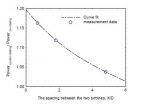(Press-News.org) Researchers from CIC nanoGUNE, in collaboration with ICFO and Graphenea, introduce a platform technology based on optical antennas for trapping and controlling light with the one-atom-thick material graphene. The experiments show that the dramatically squeezed graphene-guided light can be focused and bent, following the fundamental principles of conventional optics. The work, published yesterday in Science, opens new opportunities for smaller and faster photonic devices and circuits.
Optical circuits and devices could make signal processing and computing much faster. "However, although light is very fast it needs too much space", explains Rainer Hillenbrand, Ikerbasque Professor at nanoGUNE and UPV/EHU. In fact, propagating light needs at least the space of half its wavelength, which is much larger than state-of-the-art electronic building blocks in our computers. For that reason, a quest for squeezing light to propagate it through nanoscale materials arises.
The wonder material graphene, a single layer of carbon atoms with extraordinary properties, has been proposed as one solution. The wavelength of light captured by a graphene layer can be strongly shortened by a factor of 10 to 100 compared to light propagating in free space. As a consequence, this light propagating along the graphene layer - called graphene plasmon - requires much less space.
However, transforming light efficiently into graphene plasmons and manipulating them with a compact device has been a major challenge. A team of researchers from nanoGUNE, ICFO and Graphenea – members of the EU Graphene Flagship - now demonstrates that the antenna concept of radio wave technology could be a promising solution. The team shows that a nanoscale metal rod on graphene (acting as an antenna for light) can capture infrared light and transform it into graphene plasmons, analogous to a radio antenna converting radio waves into electromagnetic waves in a metal cable.
"We introduce a versatile platform technology based on resonant optical antennas for launching and controlling of propagating graphene plasmons, which represents an essential step for the development of graphene plasmonic circuits", says team leader Rainer Hillenbrand. Pablo Alonso-González, who performed the experiments at nanoGUNE, highlights some of the advantages offered by the antenna device: "the excitation of graphene plasmons is purely optical, the device is compact and the phase and wavefronts of the graphene plasmons can be directly controlled by geometrically tailoring the antennas. This is essential to develop applications based on focusing and guiding of light".
The research team also performed theoretical studies. Alexey Nikitin, Ikerbasque Research Fellow at nanoGUNE, performed the calculations and explains that "according to theory, the operation of our device is very efficient, and all the future technological applications will essentially depend upon fabrication limitations and quality of graphene".
Based on Nikitin´s calculations, nanoGUNE's Nanodevices group fabricated gold nanoantennas on graphene provided by Graphenea. The Nanooptics group then used the Neaspec near-field microscope to image how infrared graphene plasmons are launched and propagate along the graphene layer. In the images, the researchers saw that, indeed, waves on graphene propagate away from the antenna, like waves on a water surface when a stone is thrown in.
In order to test whether the two-dimensional propagation of light waves along a one-atom-thick carbon layer follow the laws of conventional optics, the researchers tried to focus and refract the waves. For the focusing experiment, they curved the antenna. The images then showed that the graphene plasmons focus away from the antenna, similar to the light beam that is concentrated with a lens or concave mirror.
The team also observed that graphene plasmons refract (bend) when they pass through a prism-shaped graphene bilayer, analogous to the bending of a light beam passing through a glass prism. "The big difference is that the graphene prism is only two atoms thick. It is the thinnest refracting optical prism ever", says Rainer Hillenbrand. Intriguingly, the graphene plasmons are bent because the conductivity in the two-atom-thick prism is larger than in the surrounding one-atom-thick layer. In the future, such conductivity changes in graphene could be also generated by simple electronic means, allowing for highly efficient electric control of refraction, among others for steering applications.
Altogether, the experiments show that the fundamental and most important principles of conventional optics also apply for graphene plasmons, in other words, squeezed light propagating along a one-atom-thick layer of carbon atoms. Future developments based on these results could lead to extremely miniaturized optical circuits and devices that could be useful for sensing and computing, among other applications.
INFORMATION:
Original publication
P. Alonso-González1, A.Y. Nikitin1,5, F. Golmar1,2, A. Centeno3, A. Pesquera3, S. Vélez1, J. Chen1, G. Navickaite4, F. Koppens4, A. Zurutuza3, F. Casanova 1,5, L.E. Hueso 1,5 and R. Hillenbrand 1,5. "Controlling grapheme plasmons with resonant metal antennas and spatial conductivity patterns" Science (2014), DOI: 10.1126/science.1253202
1 CIC nanoGUNE, 20018 Donostia-San Sebastián, Spain.
2 I.N.T.I-CONICET and ECyT-UNSAM, San Martín, Bs. As., Argentina.
3 Graphenea SA, 20018 Donostia-San Sebastián, Spain.
4 ICFO-Institut de Ciéncies Fotoniques, Mediterranean Technology Park, 08860 Casteldefells, Barcelona, Spain.
5 IKERBASQUE, Basque Foundation for Science, 48011 Bilbao, Spain.
Flatland optics with graphene
2014-05-23
ELSE PRESS RELEASES FROM THIS DATE:
Bacterial adaptation contributes to pneumococcal threat in sickle cell disease patients
2014-05-23
Researchers have identified differences in the genetic code of pneumococcal bacteria that may explain why it poses such a risk to children with sickle cell disease and why current vaccines don't provide better protection against the infection. St. Jude Children's Research Hospital scientists led the study, which appeared earlier this month in the journal Cell Host & Microbe.
The findings will aid efforts to improve vaccine effectiveness and inform research into new ways to protect young sickle cell disease patients from life-threatening pneumococcal infections that can ...
Breakthrough in RSV research to help infected children
2014-05-23
Researchers at Le Bonheur Children's Hospital and the University of Tennessee Health Science Center announced results today from a clinical trial of a drug shown to safely reduce the viral load and clinical illness of healthy adult volunteers intranasally infected with respiratory syncytial virus (RSV).
Detailed results of this study were presented by lead researcher Infectious Disease Specialist John DeVincenzo, MD, this week during a poster discussion session at the American Thoracic Society 2014 International Conference in San Diego. He serves as medical director of ...
Argonne scientists discover new phase in iron-based superconductors
2014-05-23
Scientists at the U.S. Department of Energy's Argonne National Laboratory have discovered a previously unknown phase in a class of superconductors called iron arsenides. This sheds light on a debate over the interactions between atoms and electrons that are responsible for their unusual superconductivity.
"This new magnetic phase, which has never been observed before, could have significant implications for our understanding of unconventional superconductivity," said Ray Osborn, an Argonne physicist and coauthor on the paper.
Scientists and engineers are fascinated ...
Health-care professionals must be aware of rarer causes of headaches in pregnancy
2014-05-23
Most headaches in pregnancy and the postnatal period are benign, but healthcare professionals must be alert to the rarer and more severe causes of headaches, suggests a new review published today (23 May) in The Obstetrician & Gynaecologist (TOG).
The review looks at common causes for headaches during pregnancy and the postnatal period, possible conditions that may be associated with headaches and how healthcare professionals should manage the care of the woman appropriately.
There are 85 different types of headache. Approximately 90% of headaches in pregnancy are migraine ...
A study assesses the possibility of turning CO2 into methanol for use in transport
2014-05-23
Tecnalia has collaborated in a study for the European Parliament's Science and Technology Options Assessment Panel (STOA) on the future use of methanol, produced from carbon dioxide, in motorised transport. STOA is the panel that advises MEPs in the sphere of Science and Technology.
The study analysed the barriers –technological, environmental and economic– to producing methanol using carbon dioxide as well as the options that would allow possible uses in automobile transport in the medium and long term.
The costs and benefits were evaluated from the life cycle perspective ...
New sensor could light the way forward in low-cost medical imaging
2014-05-23
New research published today in Nature's Scientific Reports, identifies a new type of light sensor that could allow medical and security imaging, via low cost cameras.
The team of researchers from the University of Surrey have developed a new 'multispectral' light sensor that detects the full spectrum of light, from ultra-violet (UV), to visible and near infrared light.
Indeed, near infrared light can be used to perform non-invasive medical procedures, such as measuring the oxygen level in tissue and detecting tumours. It is also already commonly used in security camera ...
A new concept to improve power production performance of wind turbines in a wind farm
2014-05-23
Wind energy is one of the most promising renewable energy resources in the world today. Dr. Hui Hu and his group at Iowa State University studied the effects of the relative rotation directions of two tandem wind turbines on the power production performance, the flow characteristics in the turbine wake flows, and the resultant wind loads acting on the turbines. The experimental study was performed in a large-scale Aerodynamics/Atmospheric Boundary Layer (AABL) Wind Tunnel available at Aerospace Engineering Department of Iowa State University. Their work, entitled "An experimental ...
Healthcare professionals must be aware of rarer causes of headaches in pregnancy
2014-05-23
Most headaches in pregnancy and the postnatal period are benign, but healthcare professionals must be alert to the rarer and more severe causes of headaches, suggests a new review published today (23 May) in The Obstetrician & Gynaecologist (TOG).
The review looks at common causes for headaches during pregnancy and the postnatal period, possible conditions that may be associated with headaches and how healthcare professionals should manage the care of the woman appropriately.
There are 85 different types of headache. Approximately 90% of headaches in pregnancy are migraine ...
Yale Cancer Center's tip sheet for the 50th Annual Meeting of ASCO May 30 - June 3, 2014
2014-05-23
The news items below are from oral presentations or poster sessions scheduled for the 50th annual ASCO conference.
Yale Cancer Center will have experts available to speak with the media before or during ASCO.
Survival, response duration, and activity by BRAF mutation (MT) status of nivolumab (NIVO, anti-PD-1, BMS-936558, ONO-4538) and ipilimumab (IPI) concurrent therapy in advanced melanoma (MEL). (LBA #9003)
Authors: Mario Sznol, Harriet M. Kluger, Margaret K. Callahan, Michael Andrew Postow, Ruth Ann Gordon, Neil Howard Segal, Naiyer A. Rizvi, Alexander M. Lesokhin, ...
Parents 'need to be convinced' to let children walk to school
2014-05-23
Parents need to be convinced about the benefits of their children walking or cycling to school as much as the children themselves, according to research led at the University of Strathclyde.
A study of children's habits in commuting to and from school discovered that, in the vast majority of cases, parents were the main decision makers in how the children travelled.
Colder weather in autumn and winter led to a drop in the number of children in an intervention group, who were being encouraged to walk and cycle more, and the control group, who continued their normal ...

